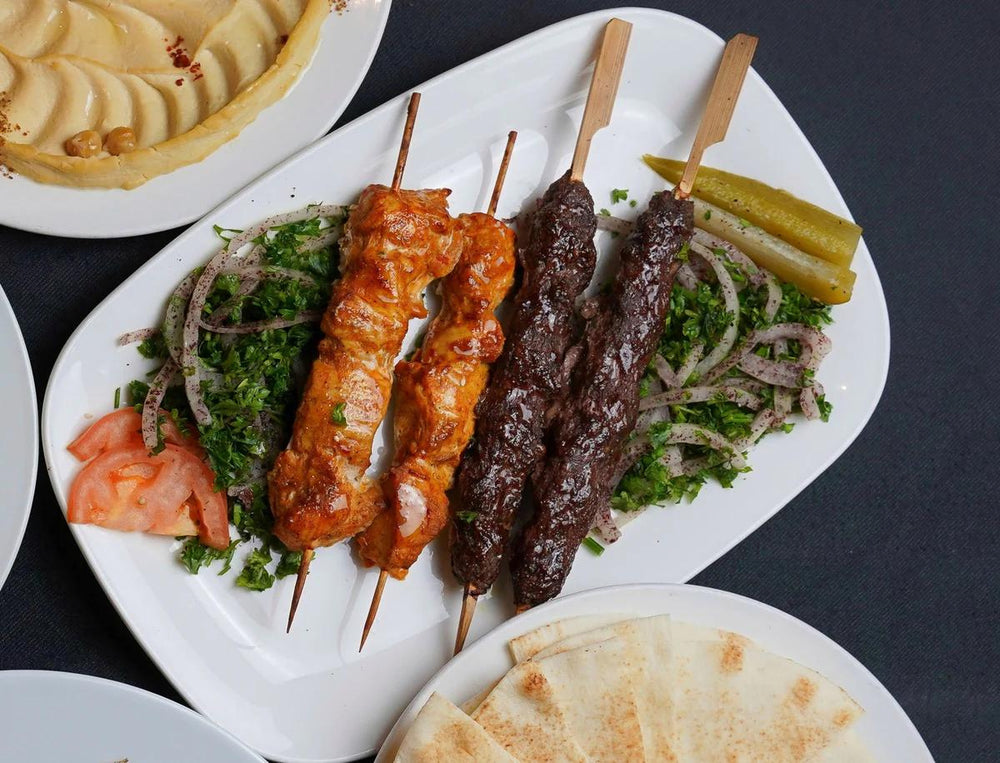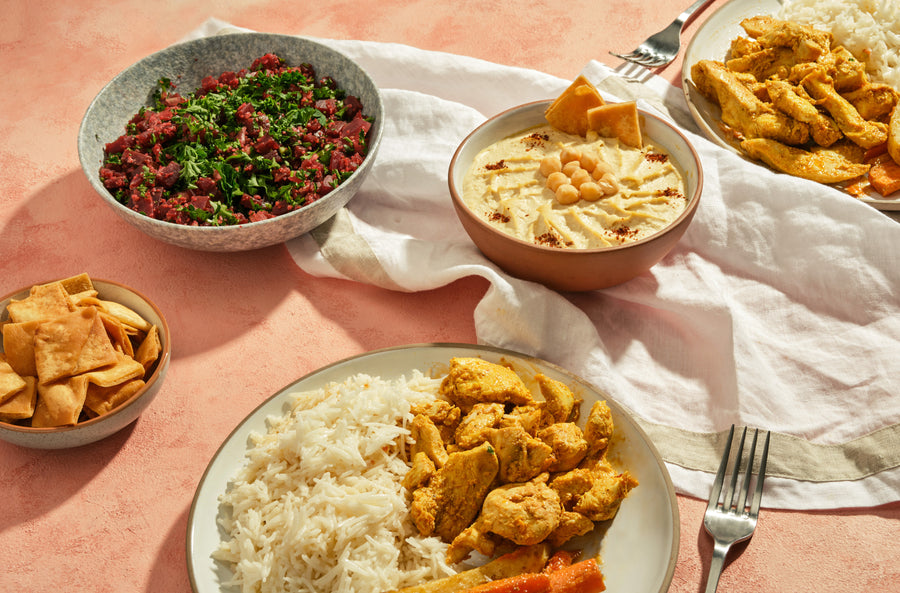A Deep Study Syrian Food: Understanding Its Cultural Relevance and Halal Aspects
Syrian food symbolizes an abundant tapestry of historical stories and cultural influences. Each dish tells a story of neighborhood and tradition, highlighting the significance of common meals. The adherence to halal practices not only mirrors faiths however also forms the identification of Syrian cooking. As global events test these culinary traditions, the strength of this food remains a centerpiece of cultural preservation. What exists behind the flavors that define this sustaining heritage?
The Historical Origins of Syrian Food
Although Syrian cuisine has developed over centuries, its historic origins are deeply intertwined with the region's varied cultural influences. Positioned at the crossroads of numerous people, Syria has taken in culinary methods from the Phoenicians, Greeks, Romans, and Ottomans, amongst others. This abundant tapestry of history has contributed to a food characterized by a mix of tastes, seasonings, and food preparation strategies. The productive lands of the area have additionally played a necessary function, offering an abundance of grains, fruits, and veggies that develop the structure of numerous dishes. The intro of new active ingredients via trade and conquest further improved the cooking landscape, permitting for the advancement of special local specializeds. In addition, the influence of surrounding nations has resulted in a vibrant exchange of culinary concepts, solidifying Syria's placement as a significant gamer in the more comprehensive context of Middle Eastern gastronomy.

Typical Syrian Dishes and Their Cultural Value
Conventional Syrian recipes are not just culinary staples but likewise carry deep cultural importance, showing the nation's abundant heritage. Renowned dishes, frequently prepared during cheery occasions, work as a method of joining neighborhoods and family members. These dishes symbolize the tastes of Syria while strengthening social bonds with shared traditions and celebrations.
Iconic Syrian Staples
When checking out the abundant tapestry of Syrian food, one finds a selection of famous recipes that not only tantalize the taste buds but also personify the country's social heritage. Amongst these staples, Kabsa stands apart as a fragrant rice meal, usually experienced with spices like saffron and cardamom, representing friendliness. Fattoush, a dynamic salad made with mixed environment-friendlies and crunchy bread, shows the value of fresh components in Syrian food preparation. Muhammara, a spicy dip made from peppers and walnuts, showcases the rich tastes particular of the region. Furthermore, Kibbeh, a dish made from bulgur and minced meat, is usually considered as a nationwide prize, representing public celebrations. Each recipe informs a story, connecting people to their roots and traditions.
Joyful Meal Traditions
Syrian festive meal practices are abundant with meaning and significance, as families collect to commemorate crucial events with the sharing of cherished meals. Dishes commonly showcase a selection of standard foods, with dishes like mansaf, tabbouleh, and kibbeh taking spotlight. Each meal brings cultural background; for circumstances, kibbeh, made from bulgur and minced meat, stands for friendliness and wealth. During Ramadan and Eid, family members prepare special sugary foods such as maamoul, signifying joy and unity. These events foster community bonds, as sharing a meal indicates love and togetherness. The preparation and enjoyment of these recipes mirror Syria's diverse culinary heritage, intertwining family members custom-mades and local influences, therefore enriching the festive experience and maintaining social identification.
The Duty of Family and Neighborhood in Syrian Food Culture
Food serves as an essential thread that weaves with each other family members and community in Syrian society. Meals are frequently communal experiences, where households gather around a table to share standard meals that mirror their heritage. The prep work of food is a common activity, with generations working side by side, passing down recipes and cooking techniques. This technique strengthens domestic bonds and promotes a feeling of belonging within the community.Special events and spiritual events even more highlight the value of food in Syrian culture. Throughout these events, families prepare intricate dishes that serve not only to nourish yet also to reveal love and friendliness. The act of sharing food signifies unity and assistance among next-door neighbors and friends, reinforcing social connections. Through these shared cooking experiences, Syrians cultivate a solid identity rooted in their rich social history, highlighting exactly how food goes beyond simple food to come to be a vital part of their social fabric.
Halal Practices in Syrian Food Preparation
In the context of public dishes and household events, halal techniques play a considerable role in Syrian food preparation. These methods originate from Islamic dietary regulations, ensuring that food is prepared and consumed in a way that aligns with religious beliefs. For many Syrian families, adherence to halal principles affects numerous aspects of meal prep work, from sourcing active ingredients to cooking methods.Animals utilized for meat needs to be slaughtered according to particular standards, highlighting gentle therapy and conjuring up the name of Allah. Furthermore, cross-contamination with non-halal things is meticulously avoided in both home cooking areas and business establishments.This dedication to halal not just shows spiritual dedication but additionally promotes a feeling of community, as families frequently integrated to share meals that recognize these practices - Brunch Kitsilano Vancouver BC. Consequently, halal methods are deeply woven into the textile of Syrian cooking culture, shaping both day-to-day life and cheery occasions
Active Ingredients That Define Syrian Tastes

The essence of Syrian cuisine is formed by a harmonious blend of key seasonings and natural herbs that boost its distinctive flavors. Standard food preparation techniques better elevate these components, showcasing the rich cooking heritage of the region. A review of vital active ingredients discloses the foundational role they play in creating authentic Syrian dishes.
Key Seasonings and Natural Herbs
A vivid tapestry of flavors characterizes Syrian food, with key flavors and herbs playing a crucial function in defining its significance. Popular among these are sumac, cumin, and coriander, which offer deepness and heat to different dishes. Cumin, with its nutty aroma, often improves stews and barbequed meats, while coriander includes a citrusy note to dips and salads. Sumac, known for its tangy flavor, lightens up meals and is frequently sprayed over fattoush or kebabs. Furthermore, cinnamon and allspice give a refined sweetness, commonly discovered in both full-flavored and pleasant prep work. Fresh herbs like parsley, mint, and dill are also vital, providing a burst my company of quality and balancing the rich, complex flavors that make Syrian food distinct.
Typical Food Preparation Methods
Food preparation strategies in Syrian food show a deep-rooted practice that enhances the flavors of its active ingredients. Approaches such as slow-cooking and braising are frequently used, allowing seasonings and natural herbs to fuse perfectly with meats and vegetables. Cooking, particularly over charcoal, passes on a great smoky richness to recipes like kebabs, while steaming is frequently made use of for rice, maintaining its structure and taste. In addition, sautéing is favored for preparing fragrant bases, often starting with onions and garlic to develop deepness. Fermentation plays a role in developing special tastes, apparent in recipes like pickled vegetables. These methods not just highlight the quality of active ingredients yet also personify the public spirit of food preparation, bringing family members together around shared dishes soaked in tradition.
Important Active Ingredients Review
While checking out Syrian food, one promptly discovers that necessary ingredients play a crucial duty in specifying its special tastes. Olive oil, a staple, supplies richness and deepness, frequently serving as a base for numerous recipes. Fresh natural herbs, such as mint, parsley, and cilantro, contribute vivid aromas and preferences, enhancing the total experience (Brunch Kitsilano Vancouver BC). Flavors like cumin, coriander, and cinnamon are frequently utilized, including heat and complexity to dishes. Furthermore, Syrian cuisine heavily integrates grains, particularly bulgur and rice, which function as fundamental components in numerous recipes. Pulses, especially lentils and chickpeas, use both nutrition and structure. Together, these active ingredients create the unified balance that identifies Syrian meals, reflecting the nation's abundant cooking heritage and social relevance
The Effect of War on Syrian Cooking Customs
Although the battle in Syria has functioned devastation throughout the country, its influence on cooking customs reveals an intricate interplay of durability and adjustment. As neighborhoods encountered displacement, traditional dishes were modified because of the shortage of resources and components. Family members typically count on locally offered produce, incorporating brand-new flavors and strategies right into their meals, which brought about the development of one-of-a-kind analyses of traditional dishes.Moreover, the war fostered a spirit of solidarity among displaced cooks and home chefs, that shared their culinary knowledge via social networks and area kitchen areas. This sharing of recipes not only maintained cultural heritage yet also created a sense of belonging among those affected by the problem. Despite the challenges, the interest for food continues to be a unifying force, permitting people to preserve their identity and connect with their origins, also in exile. Syrian cuisine continues to advance in the middle of misfortune, showing both an abundant background and modern resilience.
Regularly Asked Questions
What Are Common Cooking Methods Used in Syrian Cuisine?
Typical food preparation strategies in Syrian cuisine include grilling, cooking, sautéing, and cooking. These techniques boost structures and tastes, enabling the creation of diverse recipes that mirror the region's abundant culinary heritage and practices.
How Has Globalization Influenced Syrian Food?

Exist Vegetarian Options in Standard Syrian Dishes?
Vegan options prevail in traditional Syrian dishes, including active ingredients like veggies, chickpeas, and lentils. Popular recipes such as Mujadara and Falafel highlight this variety, accommodating different dietary choices while preserving the abundant tastes of the cuisine.
What Beverages Pair Well With Syrian Meals?
Drinks that couple well with Syrian dishes consist of mint tea, pomegranate juice, and ayran - Brunch Kitsilano Vancouver BC. These beverages match the tastes of standard meals, enhancing the eating experience while offering you can try these out stimulating contrasts to the rich, savory preferences
Exactly How Do Syrians Celebrate Food Throughout Holidays or Festivals?
Syrians celebrate food during holidays and celebrations with fancy feasts, commonly featuring typical recipes. Family events highlight sharing dishes, representing unity and cultural heritage, while unique deals with and desserts highlight the festive spirit and common joy. Typical Syrian recipes are not only culinary staples yet additionally lug deep cultural importance, mirroring the country's rich heritage. When discovering the rich tapestry of Syrian food, one finds a selection of renowned recipes that not only entice the taste but additionally embody the country's social heritage. Syrian cheery meal traditions are rich with symbolism and importance, as family members collect to celebrate essential events via the sharing of cherished meals. Food preparation methods in Syrian food show an ingrained tradition that improves the flavors of its components. Vegetarian options are special info widespread in conventional Syrian recipes, including ingredients like vegetables, lentils, and chickpeas.